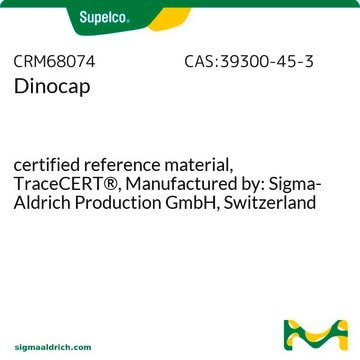133221
Bis(5-chlor-2-hydroxyphenyl)methan
95%
Synonym(e):
Dichlorophen
About This Item
Empfohlene Produkte
Assay
95%
Form
powder
mp (Schmelzpunkt)
168-172 °C (lit.)
Löslichkeit
95% ethanol: soluble 1g/g
methanol: soluble
petroleum ether: soluble
toluene: very slightly soluble
water: insoluble
SMILES String
Oc1ccc(Cl)cc1Cc2cc(Cl)ccc2O
InChI
1S/C13H10Cl2O2/c14-10-1-3-12(16)8(6-10)5-9-7-11(15)2-4-13(9)17/h1-4,6-7,16-17H,5H2
InChIKey
MDNWOSOZYLHTCG-UHFFFAOYSA-N
Suchen Sie nach ähnlichen Produkten? Aufrufen Leitfaden zum Produktvergleich
Allgemeine Beschreibung
Anwendung
Haftungsausschluss
Signalwort
Warning
H-Sätze
Gefahreneinstufungen
Acute Tox. 4 Oral - Aquatic Acute 1 - Aquatic Chronic 1 - Eye Irrit. 2
Lagerklassenschlüssel
11 - Combustible Solids
WGK
WGK 3
Flammpunkt (°F)
Not applicable
Flammpunkt (°C)
Not applicable
Persönliche Schutzausrüstung
dust mask type N95 (US), Eyeshields, Gloves
Analysenzertifikate (COA)
Suchen Sie nach Analysenzertifikate (COA), indem Sie die Lot-/Chargennummer des Produkts eingeben. Lot- und Chargennummern sind auf dem Produktetikett hinter den Wörtern ‘Lot’ oder ‘Batch’ (Lot oder Charge) zu finden.
Besitzen Sie dieses Produkt bereits?
In der Dokumentenbibliothek finden Sie die Dokumentation zu den Produkten, die Sie kürzlich erworben haben.
Unser Team von Wissenschaftlern verfügt über Erfahrung in allen Forschungsbereichen einschließlich Life Science, Materialwissenschaften, chemischer Synthese, Chromatographie, Analytik und vielen mehr..
Setzen Sie sich mit dem technischen Dienst in Verbindung.









